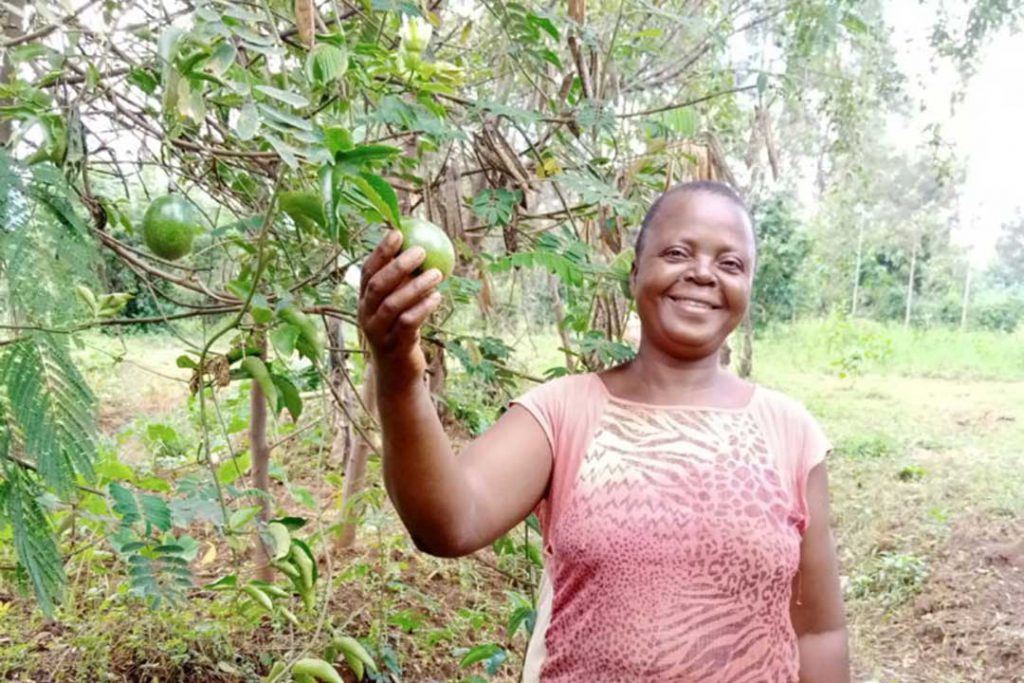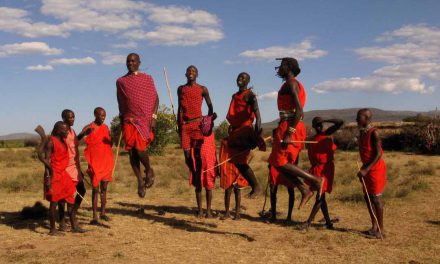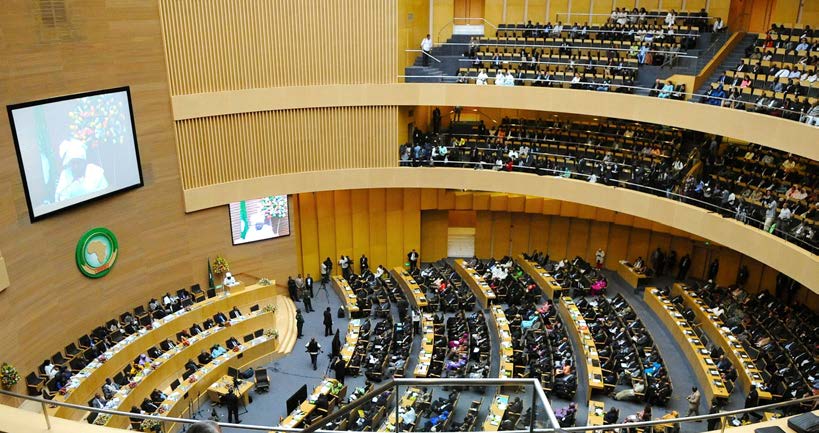Agro-ecology enterprises are helping to cushion African farmers and smallholders against climate change, improve nutrition and generate income.
Chirping birds welcome you to Bio Gardening Innovations (BIOGI) a local not-for-profit organisation and demonstration centre in Vihiga county, western Kenya. The centre is a mass of fruit trees, other exotic and indigenous tree species and vegetables, tuber crops, a rabbit hutch, a fishpond filled with collected rainwater, and a kitchen. Though measuring less than an acre, the centre resembles a natural forest teeming with abundance.

Ruth Okalo in her food forest garden, which has avocado trees, passion fruit and Leucaena leucocephala, a tropical forage tree whose leaves she uses for fodder and firewood Photo: Justus Wanzala
BIOGI’s goals are to address challenges of climate change, deforestation and food insecurity through innovative agro- ecological principles and sustainable management of natural resources, and the NPO works with more than 2,000 smallholder farmers and their groups in Vihiga and Kakamega counties. The two counties have one thing in common, a high population density. Vihiga has a population density of 1,047 people per square kilometre, while Kakamega has a density of 618 per square kilometre.
Population density has contributed to deforestation, soil degradation and biodiversity loss in the region, but farmers, in partnership with BIOGI, have set up community learning ecosites as places to incubate new ideas for how to create regenerative enterprises in support of livelihoods in a sustainable manner. These enterprises include setting up food forests or organic gardens, in addition to rearing small livestock to cushion farmers and smallholders against climate, improve nutrition and generate income.
Farmers are also taught innovative approaches to crop and animal husbandry. These include aspects of permaculture, seed banking, organic farming, pre- and post-harvest handling and bio-fertiliser making. Ferdinand Wafula, BIOGI’s Chief Executive Officer, explains that the food forests concept is a farming system that involves integrating trees into food gardens. Food forests, he says, mimic natural forests. “Soil degradation and high demand for wood fuel led to deforestation and poor harvests, which prompted farmers to collectively seek innovative remedies that ensure sustainable agriculture,” he explains.
Simon Amwoyo is among the local farmers affiliated to BIOGI. Amwoyo undertakes various activities on his one hectare farm, where he grows a variety of fruit trees such as mangoes and avocados, as well as Grevillea Robusta, a species used as a source of wood for fuel and timber. He also grows Calliandra and Sesbania trees, which provide fodder. “I have a tree forest and I also grow cassava, pumpkins, sweet potatoes, bananas and indigenous vegetables,” Amwoyo says, adding that the skills offered by BIOGI have enabled him to establish a fishpond, an apiary and keep livestock. He has also learnt better ways of using wood-fired cooking stoves and to recycle farm waste for organic manure, all of which have enabled him to meet the daily needs of his household.
Likewise, Ruth Okalo, who is also affiliated to BIOGI, says she has been able to seamlessly incorporate her food forest and organic garden into rearing livestock. Okalo, who grows bananas, sweet potatoes and indigenous vegetables alongside fruits and Grevillea Robusta, also rears dairy cattle. “I am self-reliant and I supplement the income of my husband instead of depending on him as I used to do before becoming a member of BIOGI,” she says. Wafula says the practices espoused by BIOGI are turning around the lives of farmers because they mitigate against climate change and environmental degradation.
The forest cover provides protection for food and fodder crops, increasing the production of food and other farm goods that meet farmers’ needs in the short-, mid- and long-term, he says. Food forests also contribute to improving Kenya’s forest cover, given that the national average is less than 8%. The farmers, he adds, are also involved in regenerative enterprises such as converting waste into organic manure and fodder. The farmers working with BIOGI have also harnessed indigenous knowledge to ensure climate resilience, Wafula says. “As part of the local culture, the community had traditional seed banks to preserve the germplasms of indigenous crops.
They knew how to undertake seed selection and methods of preserving them until next planting season.” To that end, he told Africa in Fact, they have now helped to establish a farm seed bank to preserve the seeds of endangered, indigenous crops, especially vegetables. BIOGI also educates partner smallholders on ways of preparing the produce and thus encouraging their consumption. As part of the move to include regenerative enterprises in the value chain, so boosting the local economy, the farmers prepare and sell traditional dishes using indigenous crops. Participating farmers are also taught how to establish and manage organic gardens, Wafula says.
They also receive training in integrating small livestock with crop farming, which can have benefits for nutrient recycling and renewable energy utilisation. Variants of BIOGI’s approach are appearing in other sub-Saharan countries. The approach is certainly applicable on a continent of some 51 million farms, of which 80% (41 million) are smaller than two hectares, according to the Africa Agriculture Status Report 2017 of Alliance for a Green Revolution in Africa (AGRA).
Richard Kimbowa, chairman of the International Network for Sustainable Energy (INFORSE), East Africa, says the concept is also practised in Uganda. The establishment of food forests in the East African country, he says, has resulted in a range of agroforestry systems, including the use of mangoes and avocado trees in home gardens. Food forests contribute to the maintenance of existing agro-pastoral systems involving livestock, such as cattle, goats, sheep and pigs, Kimbowa says. Food forests keep land under cover, thus mitigating degradation, deforestation and pollution from the overuse of agrochemicals.
They also provide firewood, which most farmers depend on for energy. Moreover, the trees contribute to improving air quality and the development of microclimates. Unfortunately, food forests also face various challenges. “Food forests are threatened by the policies of governments that favour large-scale and commercial farming, resulting in displacements and land grabs with considerable socioeconomic effects,” Kimbowa says. At the same time, rising population growth means that more farmers require extension services and education to help them adopt new technologies.
Chris Macoloo, Africa’s regional director for World Neighbors (WN), an international NGO that educates communities about solutions to challenges such as hunger and poverty, says many smallholder farmers may also view food forest practices as competition for other profitable land uses such as cropping and livestock rearing. “Trees are seen as competing with crops for available and limited essential resources such as labour, water and nutrients. The farmers we work with also initially lack the skills and technical expertise needed for establishing and managing agroforestry systems.”
But he agrees that food forests enhance food security and biodiversity protection. “They create a suitable habitat for wildlife and insects, including pollinators,” he says. “They also enrich the soil with organic matter and support the control of pests and diseases, enhancing and promoting agro-ecology.” Partner farmers work on their own farms, and are therefore more motivated to plant and manage the trees than those who cultivate communal areas. Moreover, he says, research has shown that vegetables, fruit trees and shrubs are more productive when cultivated in a near-natural habitat model such as that provided by the food forests.
The UN Food and Agriculture Organization (FAO) runs a project, the Forest and Farm Facility (FFF), which offers financial support and technical assistance to strengthen forest and farm producer organisations, says Philip Kisoyan, a programme coordinator. He describes food forests as “multi-storey gardens” that include root crops, cover crops, vegetables and fruits. “Our goal is to enable farmers to adequately benefit from tree products such as fuel wood, timber, fodder for livestock and fruits.”
The choice of tree species to plant depends on climatic and ecological factors as well as the farmer’s needs. “Some farmers opt for multipurpose trees for fruits, fodder, timber and fuel wood, while others go for early maturing species,” says Kisoyan. The FFF works with smallholder famers in Africa, Latin America and Asia. In Africa, the programme operates in Kenya, Tanzania, Togo, Zambia Ghana and Madagascar. It is also operating in Bolivia, Latin America and Vietnam in Asia, according to Kisoyan. “Smallholder farmers are a critical part of society, but without support they can’t fully fulfil their potential,” he told Africa in Fact.
They represent a huge number of our farmers. If organised and empowered with skills and capital, they could form a significant segment of the private sector.” Supporting farmers to organise into groups and co-operatives, he adds, also empowers them to collectively seek markets, inputs and add value to their products. The food forest concept is crucial for sustainable agriculture and climate change mitigation through carbon sequestration, he argues. “There are more trees on farms than in designated forests in Kenya. Around 40% of timber sold in Kenya is from farms.”
Like other food security specialists, Kisoyan points to the many benefits offered by food forests. In his view the key factor is that they improve biodiversity, which contributes to high crop productivity by offering a habitat for pollinators – bees and birds. Like the WN’s Chris Macoloo, though, he says that the concept and practice of food forests faces challenges. Incentives to cultivate a food forest can be adversely affected by government policy, or a lack of knowledge, or the availability of appropriate technology. Kenya’s position on trees is a case in point, he says.
“When you plant a tree it’s your personal decision, but should you require to cut and transport it, you’re compelled to obtain authorisation from authorities.” All the same, food forests are gaining popularity in Africa, says Ru Hartwell, director of Community Carbon Link, which runs a forestry project connecting Wales and Kenya. The organisation is currently working with a community in Bore, along Kenya’s Indian Ocean coast, to promote farm forestry. In Hartwell’s view, food forests should also be seen as contributing part of a solution to a larger problem – climate change.
The Intergovernmental Panel on Climate Change (IPCC) has asserted that humanity will lose the battle against global warming if the tropics are not reforested, he says. “Reducing emissions in the developed world without stopping tropical deforestation won’t fix the broken climate.” The poorest people in the world – who include sub-Saharan Africa’s large number of women farmers – now hold the key to fighting climate change, says Hartwell. They are increasingly getting involved in reforesting, and growing trees for food, fodder, fuel and even medicinal purposes, he says. “No- one really appreciates it yet, but poor, marginalised women now hold the fate of the entire planet in their hands.”
Meanwhile, Stepha McMullin, a scientist at the Nairobi-based International Council for Research in Agroforestry (ICRAF), also called the World Agroforestry Centre, says her organisation promotes the cultivation of various species, including indigenous and under-utilised African food trees and crops, such as baobab, moringa and sorindeia. “These are crops with under- exploited potential for food and nutrition security and they have been ignored by researchers,” she says. “They can provide fruits, leafy vegetables, nuts, seeds, and oils into the local food system.”
However, fruit consumption remains low in sub-Saharan Africa, largely because seasonality poses a challenge. Moreover, the short windows of harvests, and gluts of certain species at particular times, lower market prices, McMullin says. “Fortunately, seasonality also provides opportunities, not just for income generation but, importantly, for food security and nutrition.” To take account of these issues, ICRAF has developed a “portfolio” approach to address the seasonal availability of foods in local food systems, based on studies of the mixes of trees and crops best suited to particular areas. Some 17 location-specific portfolios have been developed across East Africa in Kenya, Uganda, Ethiopia and Somaliland, says McMullin.
Working with national partners and local farming communities, the centre promotes relevant portfolios to local farmers, training them on the benefits of diversification, tree planting and management, and the importance of using quality seed and seedlings. McMullin believes farmers can be incentivised to adopt food forests if they are involved in the research process. Researchers need to provide them with information on the diversity of food tree species that can be cultivated in their localities, and the opportunities for income that they offer. Crops derived from trees have an additional benefit, she argues.
“The extensive roots of trees make them more drought tolerant than annual crops, so they can provide food in dry periods when other food sources are not available.” Meanwhile, Nicholas Syano, co- founder and chief executive officer of the Drylands Natural Resource Centre (DNRC), which promotes agro-ecology among farmers in eastern Kenya, agrees that food forests can play a role in climate resilience.
“This isn’t really a new concept, but rather part of indigenous knowledge which the continent had lost,” he says. Traditionally, homes would have forest gardens with food crops such as mangoes, guavas, avocadoes and cashew nuts, root crops such as sweet potatoes, as well as beans as a cover crop, vegetables, medicinal herbs, shrubs, climbers, and fruit trees, among others. BIOGI, it seems, is on the right path, back to the future.
Justus Wanzala is a Kenyan journalist who writes on the environment, climate
change, agriculture and practical technologies as well as sustainable development and social issues. Currently, he works for the Kenya Broadcasting Corporation and as a freelancer/contributor for various publications across the globe.













